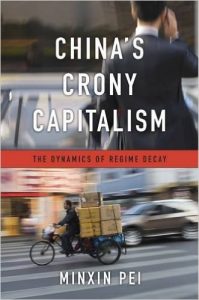America has more prisoners, some 2,240,000, than any other nation on earth – only China gets anywhere close; of the total, there are about three African Americans or Hispanics for every white. All round, the American criminal justice system is an ugly scar on the nation. President Obama said as much when he visited a prison last week, the first sitting US President to make such a visit.
David Skarbek’s [amazon_link id=”0199328501″ target=”_blank” ]The Social Order of the Underworld: How Prison Gangs Govern the American Penal System[/amazon_link], is a fascinating account of what happens inside the country’s huge and violent prisons. It uses the analytical tools of institutional economics – notably Douglass North’s and Elinor Ostrom’s explanations of how groups collectively organise themselves – to probe the internal gang-run pecking order in prisons, their drugs-based economies, and their links to external gang activity.
[amazon_image id=”0199328501″ link=”true” target=”_blank” size=”medium” ]The Social Order of the Underworld: How Prison Gangs Govern the American Penal System[/amazon_image]
The bottom line of Skarbek’s analysis is that “gangs thrive because of a demand for governance.” He traces the change from a prison social order based on conformity to social norms (the ‘convict code’), before the 1970s, to one run wholly by the gangs, with clear hierarchies and detailed rule books. Loyalty to the gang – all race-based – has to be total, on pain of death, and life-long. The gang structures connect those in prison to the outside drugs economy as well. The trigger for this shift in social order was the big increase in the prison population from the mid-1970s: “Norms will be effective at providing governance when the inmate population is relatively small, but as it grows norms will break down.” In addition to the size factor, the growth in the prison population meant a big increase in the proportion of new, inexperienced prisoners who did not know the norms, and many of them younger men who did not care, and were often more violent. Inmate violence rose dramatically in the early 1970s.
Prison officials were unable – in the large new facilities being built or in the old and increasingly over-crowded ones – even to observe what was happening, never mind control it. The gangs filled the governance vacuum. “Gangs are quasi-governments.” (Skarbek also quotes Will Baumol’s reversal of the point – governments are quasi-gangs.) What’s more, the gangs play the community assurance role in the contraband trade that has been documented among other trading communities – by [amazon_link id=”0521480442″ target=”_blank” ]Avner Greif[/amazon_link] for example. “All members of a gang are responsible for each member’s actions.” Somebody who cheats on a deal will be punished by his fellows.
Interestingly, there are no gangs in female prisons, and women’s prisons are not racially (self-)segregated either. Skarbek allows the absence of testosterone to play a role, but argues that the main explanation is that women’s prisons are much smaller and with far fewer women incarcerated. The social order that emerges there is sorting into small ‘families’.
The book ends with some wider reflections on the importance of understanding informal economic and social institutions. I couldn’t agree more. A third of the world’s population live in countries with collapsing states. Governments are often ineffective when they exist. The world’s shadow economy is huge. Even in well-governed, stable states, there are swathes of economic life that do not touch government. “To understand aggregate economic and social outcomes, we must understand the extent to which people rely on extra-legal governance.” Inside America’s prisons, there is a formal governance vacuum but economic exchange thrives and the violence is strictly controlled by the gang leaders.
From institutional economics, the conditions for informal governance to be effective are known: enough social or cultural homogeneity; small enough for reputation to leverage good behaviour; simple, easy-to-monitor economic exchanges, with stakes that are not too high; high self control, patience; and repeated exchanges. Yet as Skarbek shows even in the unpromising conditions of the prison world, effective governance can emerge.
How could America reform its prisons and reduce the power of the criminal gangs? Skarbek suggests making prisons smaller and safer, and incarcerating far fewer people. The unwinnable “war on drugs” and tough mandatory sentencing fuelled the increase in prisoner numbers, which created the power of the gangs.
This is a terrific book. Along with Diego Gambetta’s [amazon_link id=”0691152470″ target=”_blank” ]Codes of the Underworld[/amazon_link] (& his earlier [amazon_link id=”0674807413″ target=”_blank” ]The Sicialian Mafia[/amazon_link]), it is a model example of how to use economic analysis to highlight the illegal world, without falling into the trap of economic imperialism. [amazon_link id=”B00NBDJG76″ target=”_blank” ]The Social Order of the Underworld[/amazon_link] would be a great case study for a course on institutional economics. It is also a must-read for anyone concerned about America’s absolutely shameful record on criminalising and imprisoning young, non-white men.

